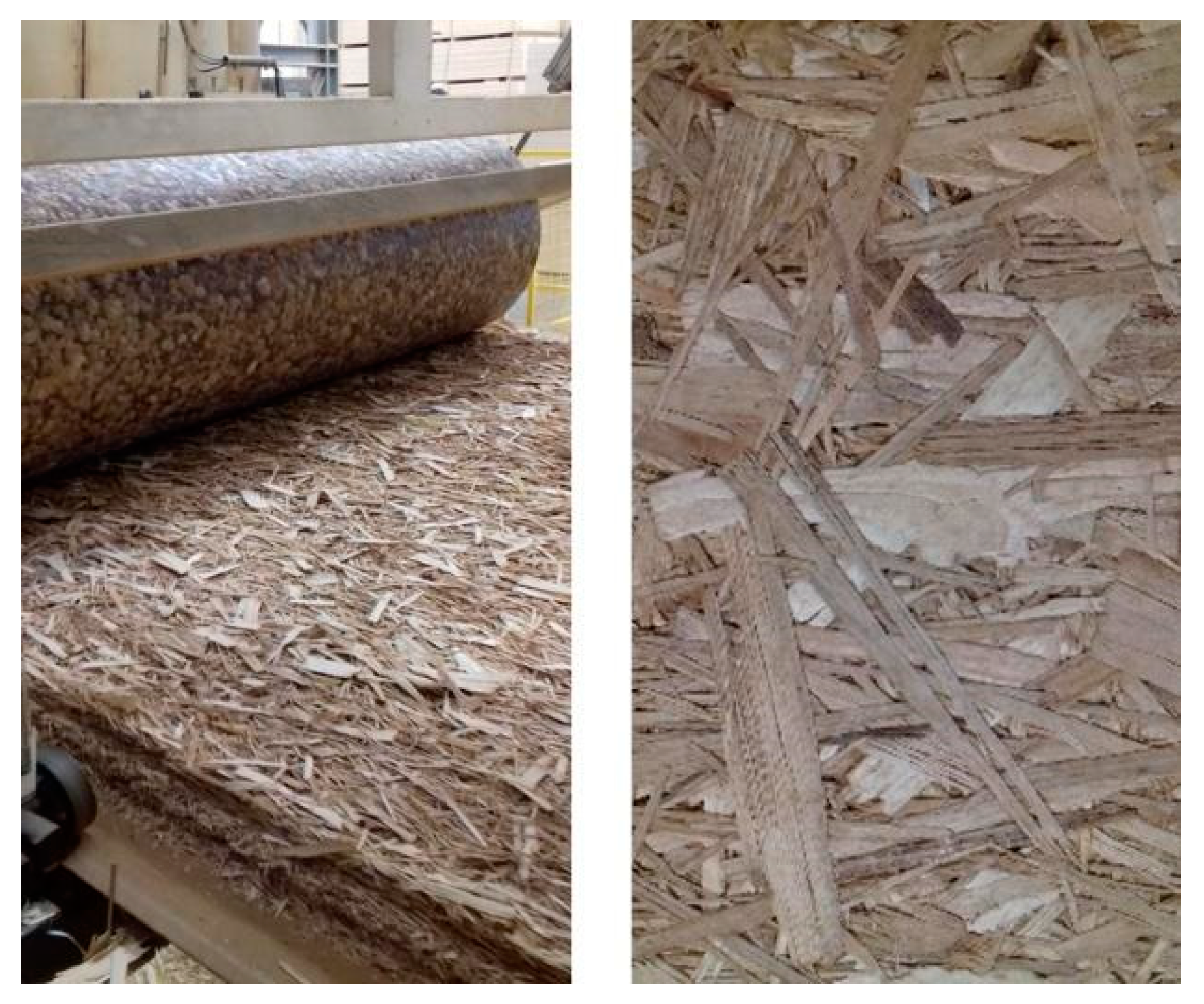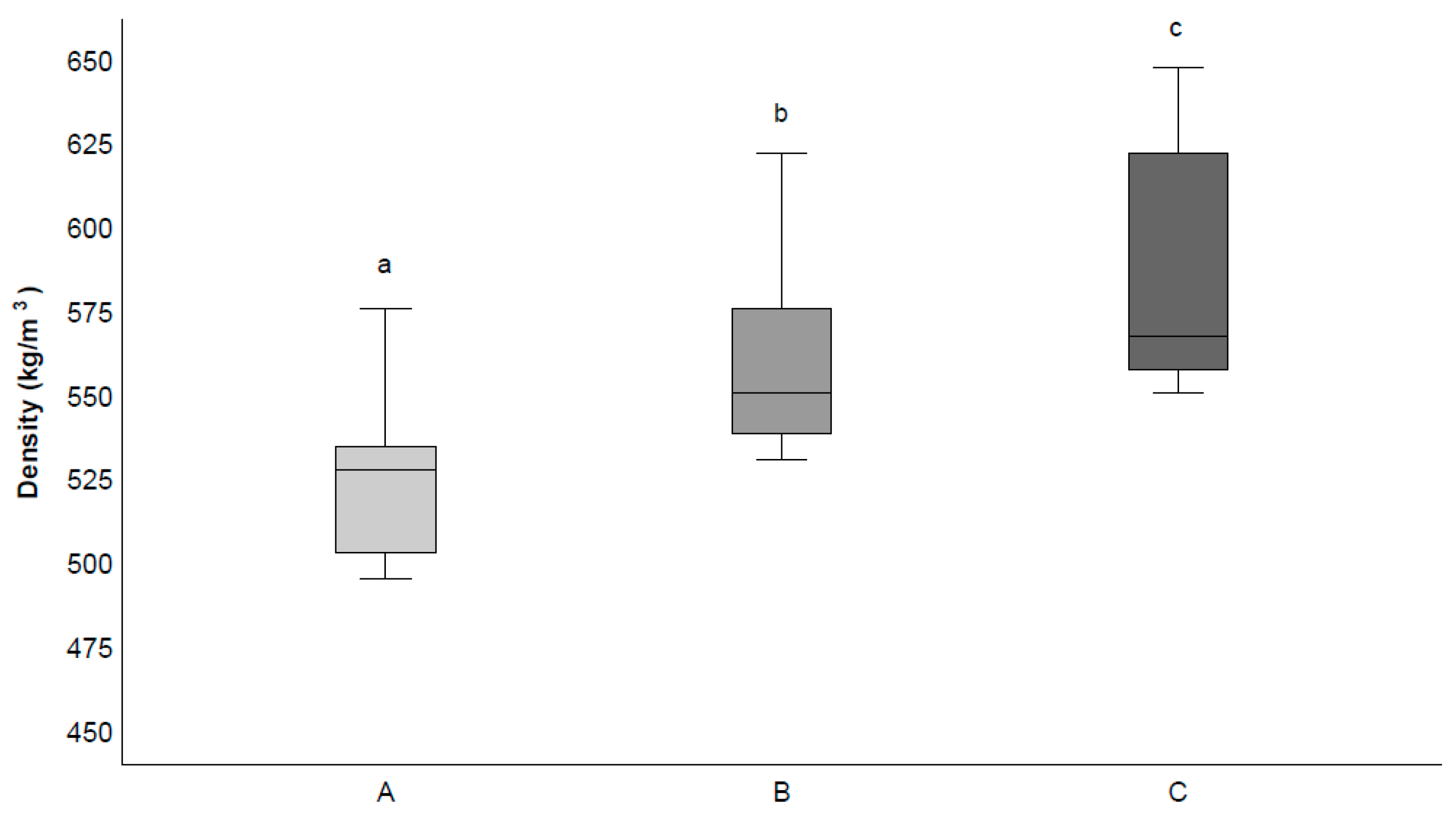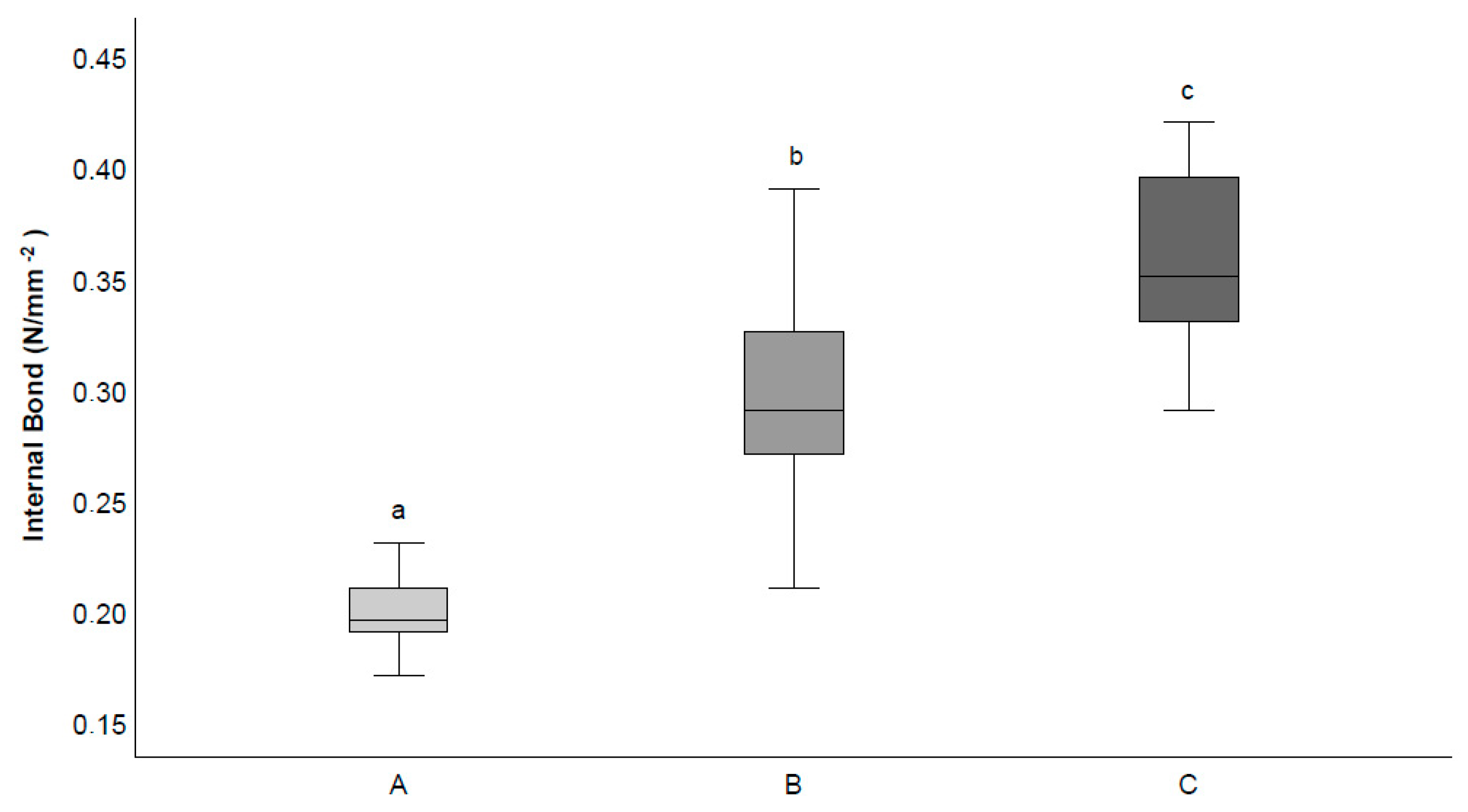1. Introduction
Sweet chestnut (
Castanea sativa Mill.) covers more than 2.5 million ha of forest in Europe, mostly in France and Italy followed by Spain, Portugal and Switzerland [
1]. In Italy, it is one of the most widespread timber species with a coverage of around 800,000 ha [
2,
3], of which 206,000 is in the North Western Piemonte Region [
4]. Despite its wide availability, the average quality of the Italian sweet chestnut wooden assortments is generally recognized as medium to low. This is due to several factors, one of the most relevant being the occurrence of ring shake that, especially for some provenances, strongly limits the yield and many industrial uses [
5]. The wide diffusion of blight and ink diseases is also detrimental [
6], while the damages from the Asian chestnut gall wasps seem to have been recently overcome [
7]. Other typical criticisms of the national forest governance, including the forest properties’ fragmentation and the failure of forest policies over the years, also hinder the possibilities of valorization of this important resource [
8]. Nowadays, most of the Italian sweet chestnut woodlands are coppice stands, whose harvestable timber is limited in size and quality [
9]. Old or unmanaged stands are also common, which further worsen the average quality. As a result, Italian sweet chestnut wood is mainly destined to be used for low-added-value applications such as tannin extraction and poles for fencing, vineyards and orchards. The higher quality assortments, when available, are used as sawnwood for joinery, flooring, doors and windows, and for a national niche market of a particular structural solid timber with wanes [
10].
An Oriented Strand Board (OSB) is a reconstituted wood-based panel made of strands bonded together, and represent a suitable use for wood of medium quality. Processing timber in short strands, in fact, does not set high requirements in terms of trunk shape and size, grain orientation and other characteristics. The European production of OSB amounted to 5.6 million m
3 in 2018 [
11], with around 77% of the market represented by the OSB/3 type (load-bearing for use in humid conditions) and 15% by the OSB/2 type (load-bearing for use in dry conditions). OSB is usually made of coniferous wood, in some cases mixed with minor shares of broadleaf woods, although in 2012 the manufacturing of 100% poplar OSB started in Northern Italy. The density of this last panel varies from 500 to 620 kg/m
3 depending on thickness, which is about 15% lighter than coniferous OSB [
12]. The use of poplar OSB is mainly intended for building and packaging, and to date is well-established on the market, reaching about 2% of the EU production. Nonetheless, some doubts recently emerged as to the continuity of supply of the raw material, due to the fact that the production capacity of the unique manufacturer amounts to 130.000 m
3 of panels per year. In recent years, in fact, the coverage of poplar plantations has decreased considerably, especially in Italy and in the Po Valley. This is mainly due to competition from the more profitable agricultural crops that can be cultivated in the plain, alluvial soils well suited to poplar [
13].
A possible solution to reduce the risk of the lack of provisions of the wood resource, is replacing poplar, partly or entirely, with sweet chestnut wood. This would guarantee a steady supply, which is vital for an OSB industry [
14], through the production of a new panel. In this framework, sweet chestnut and mixed sweet chestnut–poplar OSB would diversify the market of Italian OSB, creating potential new value chains [
15]. This could also foster a more active management of Italian woodlands and offer a new commercial outlet to forest supply chains of other European countries where sweet chestnut is present.
The primary objective of this study is to investigate the properties of OSB made of sweet chestnut wood and of mixed poplar–sweet chestnut wood, in order to assess their technical feasibility at industrial level. To this purpose, OSB with different proportions of poplar and sweet chestnut wood was manufactured on an industrial scale. Its compliance with the requirements set by the European product standard EN 300 [
16] was assessed.
2. Materials and Methods
OSB 18 mm thick with dimensions 1250 × 2500 mm (
Figure 1) was manufactured in the mill that currently produces 100% poplar OSB (I-PAN s.p.a., Casale Monferrato, Italy). The raw material consisted of poplar (‘I-214’ clone) and sweet chestnut logs from coppice stands with diameter 10–35 cm and length 150–200 cm. The strander was initially fed with poplar logs, then sweet chestnut logs gradually entered the process, resulting in a gradual shift of the mat composition from 100% poplar to 100% sweet chestnut wood.
Three types of boards made of different percentages of sweet chestnut wood (SC) and poplar wood (P) were sampled: A (50% SC-50% P), B (60% SC-40% P), C (100% SC). The percentage composition was calculated based on the input in weight of the wood entering the resination drum.
Ten boards for each type were drawn from the continuous production process, in order to have a feasible guarantee that their composition corresponded to the aforementioned percentages of different strands. The process used was the one currently used for the production of poplar OSB, including the shape and size of the cutting tools. Keeping the same manufacturing parameters for both poplar and sweet chestnut wood, in fact, was in this preliminary approach key to evaluating the industrial feasibility of the new products. In detail, OSB was bonded using a commercial polymeric diphenylmethane diisocyanate (PMDI) resin (5 kg of resin to 100 kg of wood) suited for gluing OSB in compliance with the OSB/3 type of the EN 300 standard. The continuous pressing process was performed at 248 °C at a pressure of 4 MPa, with a line speed of 95 mm/s.
Poplar and sweet chestnut strands were randomly sampled through a 500 cm3 bowl before entering the resination drum. The width and length of the strands were measured using a digital caliper (±0.01 mm accuracy) to determine their average size.
Before testing, all specimens cut for the physico-mechanical characterization were conditioned at 20 °C ± 65% until attainment of the equilibrium moisture content (EMC). Density was determined on nine specimens per panel type according to EN 323 [
17]. Specimens’ dimensions were measured by a digital caliper (±0.01 mm accuracy), whereas their weight was measured by a scale (±0.01 g accuracy).
The modulus of rupture (MoR) and modulus of elasticity (MoE) were determined according to EN 310 [
18] on 18 specimens per panel type (nine along the major axis and nine along the minor axis) using an iMAL IB600 (Imal s.r.l., San Damaso, Italy) testing machine. It is worth noting that the EN 300 defines the major axis as “the direction in the plane of the board in which the bending properties have the higher value”, and the minor axis as “the direction in the plane of the board at right angles to the major axis”.
The internal bond (IB, resistance to tension perpendicular to the plane of the board) was determined on nine specimens per panel type according to EN 319 [
19] through the aforementioned testing machine. Swelling in thickness (TS) after immersion in water was determined on nine specimens per panel type according to EN 317 [
20]; specimen dimensions were measured as already reported for density. The moisture resistance after boil test was assessed on nine specimens per panel type according to EN 1087-1 [
21]. All test results were compared with the threshold values given by the standard EN 300 for the OSB/2 and OSB/3 types.
The statistical analysis was performed using the IBM SPSS 25.0 (IBM Corp., Armonk, NY, USA) program. Differences in strand size were assessed using the Mann–Whitney U non-parametric test. Differences in density, MoR, MoE, internal bond and swelling were investigated by one-way analysis of variance (ANOVA) and LSD test as a post-hoc; homogeneity of variance was verified by Levene’s test. Significance was always set at a level of 0.05.
3. Results and Discussion
Figure 2 shows the density of the OSB produced. Significant differences (
p < 0.001) were found depending on the composition. The LSD post-hoc test showed that types A, B and C belong to different groups (
p < 0.05). This reflects the higher content of sweet chestnut wood in the boards (based on the results of the factory production control, densities at 12% moisture content of sweet chestnut and poplar wood were, respectively, 540 and 390 kg/m
3). Regardless, type C (100% sweet chestnut) turned out to be only 7% denser than the raw strands it is made of, even though a higher densification would be expected during the production process [
22]. As a comparison, the densification of the standard, 18 mm thick poplar OSB, is of about 38%. The observed limited densification can be attributed to the formation of the mat. In fact, the mat thickness is set based on weight: a heavier mat (such as that of sweet chestnut strands) is thinner than a lighter one (such as that of poplar strands). Therefore, when the sweet chestnut mat entered the continuous pressing set to reach the thickness of the final board, a lower densification was required to obtain that target thickness.
Figure 3. displays the results of the internal bond: significant differences (
p < 0.001) were found depending on the OSB type, with differences among groups always significant at
p < 0.05 level. The average internal bond increased together with the percentage of sweet chestnut wood. This can be explained first by the higher density of the boards, which is known to be directly correlated to IB, as already reported in studies on OSB made of aspen wood [
23] and mixed hardwoods [
24]. IB is also affected by density profile as well; therefore, the details of this feature shall be fine-tuned by future studies in anticipation of industrial manufacturing of the sweet chestnut OSB. In addition, it is important to acknowledge that the vessels of sweet chestnut wood with a porous ring are wider than those of poplar wood, which favors the penetration of the adhesive [
25].
Type C was found to be the best performing and met the threshold of acceptability set by the EN 300 for 18 mm thick OSB/2 (IB0.05 > 0.30 N/mm2). Types A and B did not meet the above requirement, but compliance with OSB/2 seems within the reach of type B (IB0.05 = 0.23 N/mm2). IB required by OSB/3 type, however, was never achieved: for all the OSB types, it was not possible to determine the IB after boil test (IB < 0.01 N/mm2). Overall, it can be assumed that IB was affected by the already discussed lack of applied pressure, which determined the limited contact among the strands and a higher inner porosity of the boards. In this view, providing a higher densification and adopting the gluing systems for sweet chestnut, alone or mixed with poplar wood, would presumably lead to a considerable increase in IB.
Table 1 shows the results of MoR, MoE and swelling. Significant differences (
p = 0.002) were found in MoR
major. Through post-hoc test, differences between A and C were found to be not significant (
p = 0.078), while those between A and B (
p = 0.023) and B and C (
p = 0.001) were significant. Variations in MoR
minor were significant (
p = 0.042) as well, with the following outcome from the LSD post-hoc test: A–B:
p = 0.192; B–C:
p = 0.229; A–C:
p = 0.013. As for the Modulus of Elasticity, significant differences (
p < 0.001) were found in MoE
major. In this case, the results of the LSD post-hoc test were as follows: A–B:
p = 0.019; B–C:
p < 0.001; A–C:
p = 0.020. Conversely, variations in MoE
minor were not significant (
p = 0.764). On the whole, no clear trend emerged in MoR and MoE, based on board type. The smaller size of sweet chestnut strands may have resulted in a more random orientation of the strands during the formation of the mat [
26], with a consequent undefined trend in MoR and MoE. In fact, sweet chestnut strands (average width 14.9 ± 11.2, average length 81.1 ± 11.2) were significantly narrower (
p = 0.027) and shorter (
p = 0.003) than poplar strands (average width 24.4 ± 12.9, average length 116.8 ± 34.3). This can be attributed to the cutting tools used, which have been specifically developed for poplar wood by the manufacturer. In contrast to poplar wood, sweet chestnut wood presents a periodic discontinuity in density due to its porous rings. This makes it, to some extent, more similar to coniferous wood, where the discontinuity in density is related to the alternating early- and late-wood. Therefore, stranding optimization [
27] of sweet chestnut wood could be achieved by using cutting tools with a geometry similar to that commonly used for coniferous wood.
Significant differences (p < 0.001) were found in swelling. Through the post-hoc test, differences were found not to be significant between types A and C (p = 0.185), whereas they were always significant between A and B (p < 0.001), and B and C (p < 0.001). In this case, the inner porosity due to the lack of pressure, together with the need for optimization of the gluing for sweet chestnut wood, presumably played a role in raising the swelling of type B.
In any case, MoRmajor, MoRminor, MoEmajor, MoEminor and TS of A, B and C types always met the respective limits of acceptability set by the EN 300 for 18 thick OSB/2 (MoRmajor 0.05 > 18 N/mm2; MoRminor 0.05 > 9 N/mm2; MoEmajor 0.05 > 3500 N/mm2; MoEminor 0.05 > 1400 N/mm2; TS0.95 < 20%). The above requirements were always met for OSB/3 type (for which the unique different threshold is TS0.95 < 15%) as well.
Overall, all types tested met the requirements for OSB/2 type set by EN 300, a result that is in line with other experimental studies on hardwood and mixed hardwood OSB [
28]. With respect to industrial manufacturing, 100% sweet chestnut OSB can be considered particularly interesting, since it is closer to meeting the requirements set by EN300 for OSB/3. Furthermore, this board would be clearly differentiated from poplar and coniferous OSB, which could open up new and specific market outlets. The good natural durability of sweet chestnut wood (Class DC 2 EN 350 against decay fungi [
29]) may represent a relevant added value in this regard.
4. Conclusions
Given the diffusion of sweet chestnut woodlands throughout the Italian territory, a new production of sweet chestnut OSB would represent an interesting opportunity for the national forest-wood sector. This possibility is especially valuable considering the availability of the wood resource, and the likely establishment of local supply chains with limited environmental impacts. Currently, sweet chestnut assortments are mainly used as biomass for energy purposes, but they are not particularly suited to this use, given their high tannin content. The manufacturing of OSB can valorize sweet chestnut timber, both economically and in terms of longer life cycles with further recycling possibilities. This would be consistent with the cascade use of wood encouraged by the European Union, considerably extending the period of carbon dioxide storage inside the final product. The production could also be of interest to the supply chains of other European countries where sweet chestnut stands are abundant.
The present study indicates that sweet chestnut OSB can be realized with a process similar to that currently used for manufacturing poplar OSB, and appears to require only minor modifications of some parameters. The properties of sweet chestnut OSB produced at industrial scale, in fact, were found in compliance with the requirements of EN 300 for load-bearing use in dry conditions (OSB/2). Specific adjustments in the process could presumably lead this panel to meet the requirements for load-bearing use in humid conditions (OSB/3). In this view, the use of specific fasteners and connectors, for instance, made of stainless steel, should be envisaged in order to avoid corrosion due to tannins and the low pH of sweet chestnut wood. OSB/2 and OSB/3 requirements also seem to be within the reach of mixed poplar and sweet chestnut OSB, especially for the composition 40% poplar–60% sweet chestnut.
Overall, the information provided by the current study can support, with some further technical adjustments, the initiation of industrial production of sweet chestnut OSB. Further analyses should assess the design of cutting tools suitable to process strands of an adequate size, the setup of specific adhesives and the fine-tuning of the production parameters, especially with regards to the pressure applied during the continuous process. Cost analysis and market feedback should also be investigated in order to compare sweet chestnut boards with OSBs made of different species and to assess their suitability for established or innovative uses. To this purpose, the durability of the product is going to be evaluated by the authors, as a further property useful for assessing possible new applications.











